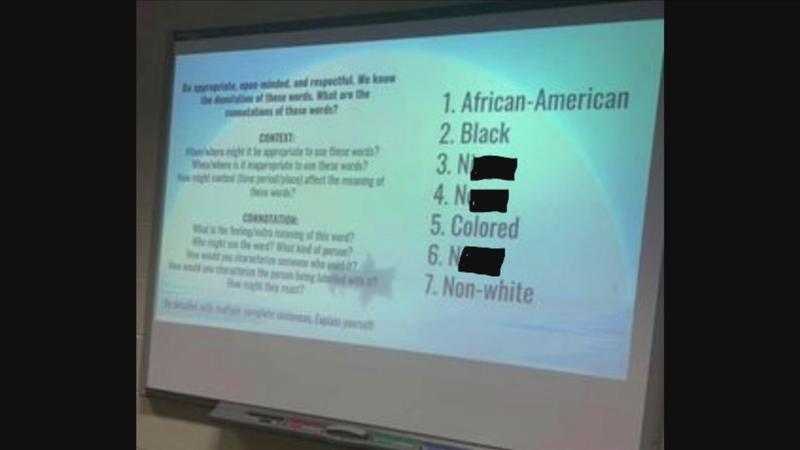N-word used in Hilton High School lesson plan for ‘To Kill a Mockingbird’
[anvplayer video=”5058765″ station=”998131″]
HILTON, N.Y. (WHEC) — Some parents are raising concern over a Hilton High School lesson plan about reading the book To Kill a Mockingbird. What most concerned the parent who contacted us were the words displayed in her son’s classroom.
It happened Wednesday in a 10th grade English class.
The Hilton Central School District said the lesson plan was trying to prepare students for reading the book, which includes the words used in the lesson plan.
One parent shared a photo taken by a student.
On the right of the screen was a list of six words, including the N-word and two similar variations of it.

A slide from a lesson at Hilton High School about the book "To Kill a Mockingbird".
On the left of the screen was a series of questions about those words including "when/where might it be appropriate to use those words?" and "when/where is it inappropriate to use those words?"
Jessyca Roberts’s son was in the class.
"I was outraged," Roberts said after seeing the photo. "I felt offended for myself and I felt offended for him."
To Kill a Mockingbird is widely read in middle and high schools.
Made into a movie with Gregory Peck, it was the story told from the perspective of a young girl, Scout, in the south about racial inequality.
The N-word is used in the book.
The Hilton School District released this statement:
The Hilton School District is aware of language that recently appeared in print during a lesson in an English 10 class that caused concern and offense to members of our school community. The language was used in context with the book To Kill a Mockingbird, a literary selection that has been taught at the high school level for many years. The book sparks conversations that are indeed uncomfortable, but the district believes these conversations need to occur in a safe environment that allows all to participate. While we want to be respectful in never speaking these offensive words, we want our students to learn about why these words have negative connotations.
The slide in question is one part of a presentation preparing students to read the classic text that is narrated by a six-year old girl, Scout Finch, who lives in Maycomb, Alabama in the 1930s. Through her eyes the reader experiences the court case of Tom Robinson, a person of color wrongly accused of a crime, and the wisdom of her father, Atticus Finch, who is the defense attorney for Mr. Robinson.
There were several steps taken by the instructor in order to prepare the class for the racial slurs and controversial themes in the book. The objective of the lesson was to ensure students understand the difference between the connotation and denotation of words. The lesson moves from commonly used words to unacceptable terms. Prior to displaying the slide in question, the instructor offered all students the opportunity to leave the room without any ramifications or judgement. The instructor numbered the words on the slide to serve as a code so that everyone could refer to the words without saying them out loud. The closure for the lesson prompts students to consider, "Why might it be important to discuss these labels and their context and connotation before starting To Kill a Mockingbird?"
The Hilton School District’s equity work includes opportunities to empower learners to be agents of positive social change. The curriculum provides the opportunity to learn about perspectives beyond one’s own scope. The Hilton School District will continue with its equity and inclusivity work in earnest and will keep our learning community informed as we move forward.
Brean: "When you saw that photo of the lesson, what did you think?"
Dr. Marck Abraham, President EMA Consulting Services: "I was disturbed on so many levels."
Dr. Marck Abraham is the president of EMA Consulting Services in Buffalo, a company that trains schools and teachers on increasing student performance and graduation, especially for students of color.
I read him part of the district’s statement including the line "the district believes these conversations need to occur in a safe environment that allows all to participate."
"It’s not just not saying the words and it’s not just saying we want to make it a safe environment. I think you want to, I don’t see the necessity in actually having to use those words that are offensive. And if you are you have to be trained un culturally relevant pedagogy and culturally relevant instruction," he said. "Those terms do nothing to move us ahead as a country and they do nothing to support the instruction and education and learning of children. White children, black children, brown children."
Enrollment data shows Hilton schools were 88% white last school year and 2% Black.